From a mobile NPP to the nuclear intelligence officer "Ladoga"
Mobile NPP
Almost half a century ago, the world's first mobile large-block nuclear power plant of the TPS-3 of low power was born, which can rightly be considered a masterpiece of mechanical engineering. In 1957, the Kirovsky Design Bureau in St. Petersburg (now OAO Spetsmash) received an order from the Ministry of Medium Machine Building (as the Ministry of Atomic Industry was then called for secrecy reasons) to build a chassis and other systems for an experienced mobile NPP. remote areas located far from power supply systems (the Far East, the North and Siberia). Of course, it is possible in these areas to create power plants that operate on both liquid and solid fuels, but the delivery of these energy sources is a serious problem.
Mobile power plant received the designation TES-3 (transportable nuclear power plant), and in KB it was called "Object 27". Since the deadlines for development were extremely tight, it was necessary to find technical solutions that were already put into practice. It was assumed that the power plant will move and on the road, and on roads with conventional pavement.
Chief Designer of Design Bureau Zh.Ya. Kotin used the T-10 tank as a base, which is extremely reliable and widely used in the army, but its chassis has undergone significant changes in connection with the specifics of the new facility. Given that the mass of TES-3 was now significantly higher than the weight of the base machine (I recall that the T-10, created under the leadership of Deputy Chief Designer, State Prize Laureate A.S. Ermolaev, had a combat mass of 51,5 tons), a special expanded track, and the chassis included an increased number of pairs of track rollers (ten versus seven). The rectangular body resembled in some way a bulky railway carriage. Leading designer of the car J.Ya. Kotin appointed P.S. Toropathin - an experienced creator of heavy tanks.
Complex engineering task was the design and development of the frame for heavy and bulky nodes. This work was entrusted to B.P. Bogdanov, and manufacturing commissioned Izhora plant. It was possible to create a lightweight and durable frame in the shape of a bridge. Subsequently, Boris Petrovich recalled: “I am still a young specialist, after graduating from the Polytech I was attached to a group designing the building of the power station. Worked hard. Frequently the chief designer came to us, showed, advised. It was not easy to place this equipment, but also really wanted to complete this task. By the way, the result of my work was the first award - the bronze medal of the Exhibition of Economic Achievements ”.
The motor-power plant was designed by the elders of the design bureau - Gleb Nikonov and Fyodor Marishkin. They then applied the most powerful diesel engine B12-6. The young specialist A. Strahal worked fruitfully. He designed thickened protective screens. The installation was made with the participation of a large number of design and scientific organizations. The work was carried out under the guidance and with the active participation of a talented engineer, Honored Kirov worker N.M. The blue.
You can say about this man that he was the creator of the atomic age. Doctor of Technical Sciences, professor and scientist connected his life with the Kirov Plant. After graduating in 1932, MVTU im. N.E. For 30 years, Bauman worked at the Kirov Plant, and went from a design engineer to a chief designer. Back in the prewar years, in the special design bureau of the plant, which he headed, they began to create the country's first jet engines for aviation. During the Great Patriotic War, Nikolai Mikhailovich worked as deputy J.Ya. Kotina, developed heavy tanks KB and IS. In August 1943, he carried out the responsible assignment of tank builders of the tank city - on the order of the Headquarters he delivered to Moscow for display to the Supreme Commander-in-chief the models of armored vehicles they created.
In 1947, N.M. Sinev again actively joined the work on the creation of new technology in Leningrad. Nikolai Mikhailovich - one of the major talented designers of the original domestic equipment for nuclear energy, the author of inventions, which have found wide application in practice. Many of its developments in terms of technical and economic indicators are superior to their foreign counterparts. B1953 — 1961 under the guidance of N.M. The blue turbo-gear units and hermetic circulating pumps for the primary circuit of atomic shipboard installations were created at Sinevoy. His particular merit is in the development of the integrated turbine installation of the nuclear-powered Lenin nuclear submarine and the first mobile nuclear power plant TES-3 as the main designer.
The mobile complex TPP-3 was mounted on four tracked chassis using, as already mentioned, the nodes of the heavy T-10 tank. The first machine was equipped with a nuclear reactor with operating systems, the second with steam generators, a volume compensator and circulation pumps for feeding the primary circuit, the third with a turbo generator, and the fourth with a central control panel for the nuclear power plant. A feature of TPP-3 was the fact that for its operation there was no need to build special buildings and other infrastructure.
The energy part was created at the Physicotechnical Institute. A.I. Leykunsky (Obninsk, now - FSUE SSC RF-IPI), at the beginning of the 1960-ies. Two such NPPs were manufactured. The reactor itself was a cylinder with a height of 600 and a diameter of 650 mm, in which the 74 fuel assemblies with highly enriched uranium were located.
To protect against radiation around the first two machines TPP-3 on-site should be built earth protection. The reactor machine was equipped with transported biological protection, which allows for installation and dismantling work within a few hours after the reactor shutdown, as well as transporting the reactor with a partially or completely burnt-out core. During transportation, the cooling of the reactor was carried out with the help of an air radiator that provides removal to 0,3% of the nominal capacity of the installation.
In 1961, in the Institute of Physics and Energy. A.I. Leykunsky commissioned TPP-3 with a pressurized water reactor. This installation has successfully completed the entire cycle, having exhausted the project resource. In 1965, TES-3 was shut down and decommissioned. Subsequently, it was to serve as the basis for the development of power plants of this type.
After trial operation in Obninsk, the two most “dangerous” machines were mothballed, but after a few years it was necessary to send them for experimental research to Kamchatka (to thermal steam geysers). To this end, Tesn Engineer L. Zakharov, Test Laboratory Engineer of the LKZ Design Office, and Deputy Chief of the SI Test Department were posted to Obninsk. Lukashev with mechanics-drivers. Engineer Vanin was sent to Kamchatka.
It should be emphasized that the strongest earthquakes were not terrible for this mobile NPP: the tank suspension didn’t stand the way it was fired.
Technical characteristics of mobile TPP-3
Total weight, t ..................................... More than 300
Mass of equipment, t ......................... About 200
Engine power, hp ................................. 750
Heat output, kW ........................... 8,8 th.
Electric power
turbogenerator, kW ..................................... 1500
Cooling water consumption
in the primary circuit, t / h ....................................... 320
Water pressure, atm ............ 130, at temperature
270'C cooler (inlet) and 300 * C (outlet);
Vapor pressure ......... 20 atm with temperature 280 "С
Duration of work
(campaigns) ................................... around 250 day
(with incomplete loading of elements - up to one year)
MTC "Ladoga"
The highly protected vehicle (VTS) “Ladoga” was born almost 20 years after the creation of a mobile nuclear power plant. Among tracked power machines, designed specifically for work in emergency situations, it occupies a special place.
The task to develop a highly protected vehicle in KB-3 of the Kirov Plant was received at the end of the 1970-s. Requirements for the new car were extremely tough and difficult. The PTS should have good mobility, high security and the ability to work offline for a long time. The most important requirement was the availability of reliable protection of the crew from radiation, chemical and bacteriological effects, while for people should be ensured maximum comfort. Of course, given the anticipated difficult operating conditions of the product, increased attention was paid to communications. In addition, the PTS should be prepared in a short time, while, if possible, unifying it with other machines of the plant.
Without exaggeration, we can say that thanks to the accumulated experience, powerful production and test bases, Leningrad designers managed to create a unique tracked vehicle that has no world analogues.
Works on "Ladoga" headed by VI. Mironov, a talented engineer and a great organizer. Over the 45 years of his career, he has gone from a design engineer to deputy general designer, head of a special bureau. In 1959, immediately after graduating from the Leningrad Polytechnic Institute (specializing in tracked vehicles), he was actively involved in virtually all the work of the Kirovsky Design Bureau before leaving for a well-deserved rest. He was repeatedly awarded, and was awarded the title of Laureate of the State Prize three times for special merits in the creation of special machines.
A special design department, KB-A, was formed at the design office. Since 1982, it has begun to perform the task. The chief of the laboratory N.I. Burenkov, chief designers of the AM Konstantinov and A.V. Vasin, leading experts V.I. Rusanov, DD Blokhin, E.K. Fenenko, V.A. Timofeev, A.V. Aldokhin, V.A. Galkin, G.B. Beetle and others.
The layout work, one of the most complicated design stages, was performed by A.G. Janson
During the design of original systems and components that ensure high compactness and reliability of the machine, the design talent of hereditary designer OK OK Ilyin manifested itself (by the way, his father, KN Ilyin, also participated in the development of the first heavy tanks and artillery systems under the guidance of N.L. Spirit). It is safe to say that Oleg Konstantinovich’s contribution to the creation of this revolutionary machine is unusually high.
The base for the PTS "Ladoga" was the spent and well-proven among the troops of the main T-80 tank chassis. An original case with a cabin was installed on it, in which comfortable chairs were placed, individual lighting, air conditioning and life support systems, communications equipment, monitoring devices and measuring various environmental parameters. This made it possible to ensure normal working conditions in a fully encapsulated cabin volume. An analogue of such a life support system can be found, perhaps, only in astronautics.
The gas turbine engine GTD-1250 with a capacity of 1250 HP, developed in the NPO named after. V. Ya. Klimova. A dust blowing system is provided with compressed air from the guide vanes of the nozzle apparatus of the turbine, which allows for quick and efficient decontamination. A gas turbine power unit with a capacity of 18 kW is located behind the left fender of the shelf, providing electricity for all Ladoga systems at the parking lots.
It is possible to provide the crew with air not through a filtering unit, but from a cylinder fixed on the rear wall of the hull. On the inner surface of the case, elements of under-antifogging are fastened. In addition to periscopes and night vision devices, there are two video cameras on the Ladoga.
At the beginning of the 1980's. The PTS "Ladoga" passed difficult tests in the Kara-Kum desert, the mountains of Kopet-Dag and Tien Shan and in the regions of the Far North. However, Ladoga was able to fully demonstrate its capabilities during the work to eliminate the consequences of the disaster at the Chernobyl nuclear power plant (ChNPP) that occurred on 26 on April 1986. As a result of the destruction of the fourth unit, a large amount of radioactive substances were released into the environment. In this situation, it was decided to use "Ladoga" - to reconnaissance and assess the situation directly at the reactor.
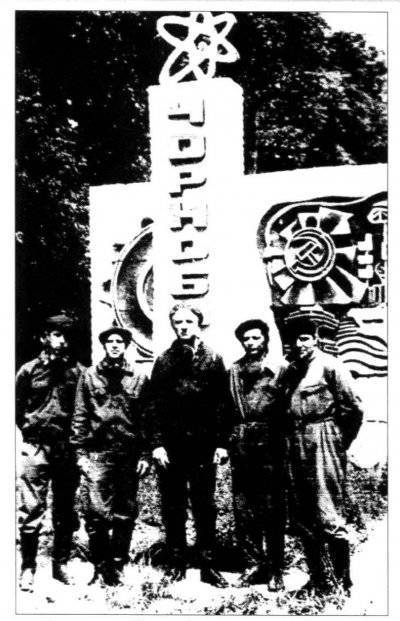 Kirovtsy in Chernobyl, second from left - G. B. Beetle. June 1986 g
Kirovtsy in Chernobyl, second from left - G. B. Beetle. June 1986 gMay 3 car (tail number 317) special flight from Leningrad delivered to Kiev. On the ninth day after the accident, she arrived at the Chernobyl nuclear power plant on her own. From the KB of the Kirov factory the work was headed by the deputy chief designer for scientific work B.A. Dobryakov and leading tester V.A. Galkin. A special detachment was created, which included the crew of the car, dosimetry, sanitation services, food service and medicine. The crews leaving for the site included the chairman of the government commission I.S. Silaev, V.K. Pikalov, academician E.P. Velikhov, a representative of the Ministry of Medium Machine Building, E.P. Slavsky and others.
B.A. Dobryakov was especially interested in technical parameters, degree of contamination, results of processing, evaluation of the operational capabilities of Ladoga systems. He, together with G.M. Gadzhibalavyv performed the most complicated calculations for security.
Participating in the work on the Chernobyl NPP test engineer GB The beetle later said: “I was struck by the devastation of villages, overgrown gardens with weeds, but the main thing was the scale of destruction: there was no roof of the block, there were no walls, one corner of the building collapsed to the very foundation. Above all, steam and curled up and out of place. While in the car, everyone watched through viewing instruments and television cameras. ”
Having worked from May to August 1986, Ladoga passed more than 4 thousand km, overcoming areas with an over-elevated background of radioactivity, conducting reconnaissance, making video recordings and performing a number of other studies, including in the Chernobyl NPP machine room.
In less than four months of work with the use of “Ladoga”, 29 specialists from the design bureau of the Kirov plant visited the Chernobyl NPP area. I would like to recall the active participants of the Chernobyl expedition: the heads of the laboratories O.E. Gerchikova and B.V. Kozhukhova, test engineers, A.P. Pichugin, as well as Yu.P. Andreeva, F.K. Shmakova, V.N. Prozorov, BC Chanyakova, N.M. Mosalova.
Of greater interest are the entries in the "logbook", which were led by experts operating "Ladoga". Here are a few snippets from May-September 1986:
Test Engineer V.A. Galkin (business trip from 9 to 24 in May 1986):
... 16.05.86. Departure to the NPP zone with members of the commission. Running time for departure: 46 km, 5,5 m / h. The radiation level of about 2500 p / h, the speedometer readings 1044 km, 85,1 m / h. No comments on the car. Deactivation. Technical indicators issued by the act.
Test Engineer A.P. Pichugin:
... 11.06.86. Departure to the zone of the NPP with m. Alexandrov. Ambient temperature + 33 ° С, specification of the contamination area.
Instrument readings: 2298 km, 162,1 m / h. For departure 47 km, 4,4 m / h. No comments. Deactivation".
Leading Engineer S.K. Kurbatov:
The tracks were tensioned, the right bracket was bent, the lamp was torn off. Defects eliminated. Deactivation. The remaining parameters in the act.
Leading Engineer V.I. Prozorov:
Test Engineer AB Petrov:
... 8.09.86 city departure to the zone of the village Pelev (4719km, 355,6 m / h) for leaving 15km / 1,6м / h. Deactivation. Parameters in the act.
September 14 “Ladoga” was shipped to the plant, after carefully deactivating the inside and outside. In the future, it was used in research works in the design bureau at site No. XXUMX (near Tikhvin).
Summing up some results, it can be said that the design office of the Kirov workers had anticipated the need for a highly protected vehicle for the Ministry of Emergency Situations with the creation of the Ladoga military-technical complex. In world practice, there are not many examples where the testing of the properties and capabilities of such a special technique would go under real conditions. The creators of "Ladoga" gained invaluable experience in extreme conditions. And today, this machine does not know for itself the equal duration of operation in conditions of increased radiation hazard.
I would like to express the hope that a technique similar to the one described above will still be in demand, especially in the context of increasingly frequent natural and man-made disasters.
Technical characteristics of the PTS "Ladoga"
Mass, t ............................................... .............. 42
Crew, cel ............................................... ........... 2
Cabin Capacity, pax ..................................... 4
Engine Type ........................................ GTD-1250
Work autonomy, h ..................................... 48
Power reserve, km .............................................. ... 350
Power density, hp.D ...................... Near 30
Speed, km / h ............................................. ...... 70
Additional power unit,
type, power ...................................... CCD, 18 kW
Literature and sources
1. Kozishkurt V.K. “Ladoga” at the nuclear crater // Modern engineering. - 2005, No. 2;
2. Efremov A.S. Tank limit parameters - a dream or a reality? // Technique and weapons. -2011, No.5.
3. Materials of the FSUE “SSC RF-FEI-”.
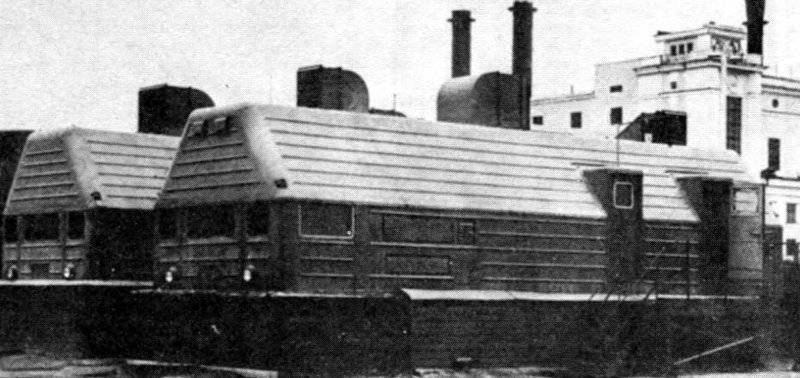
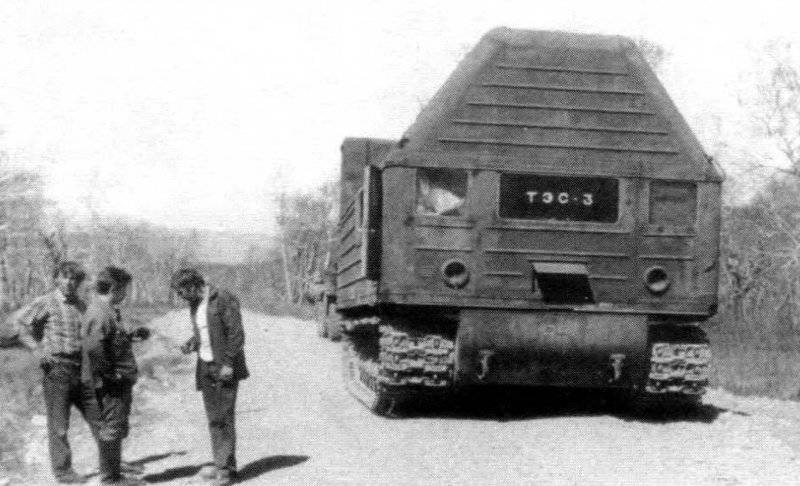
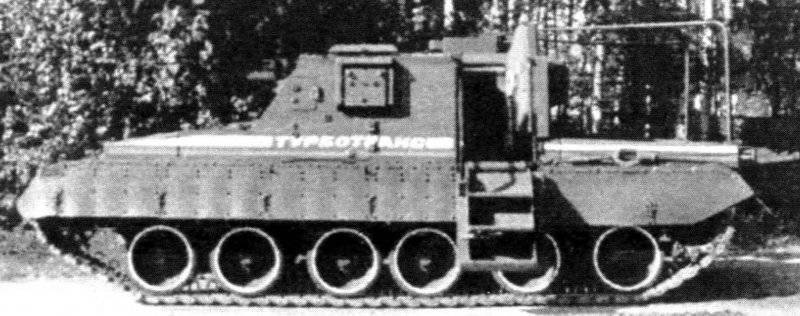
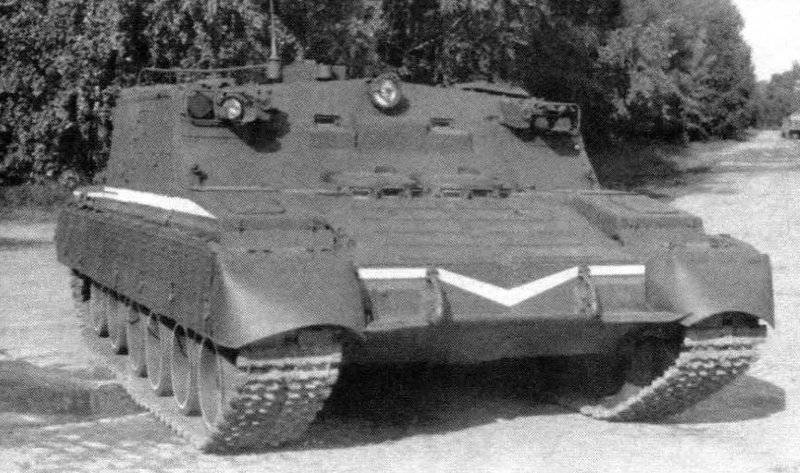
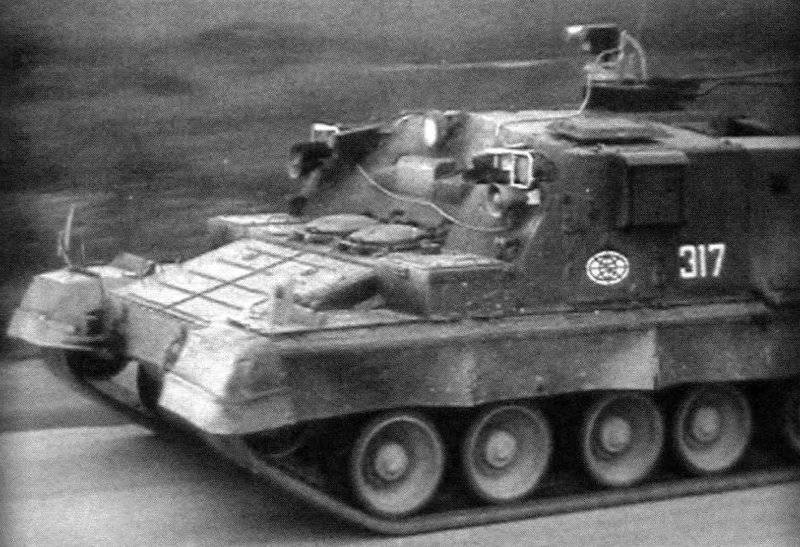
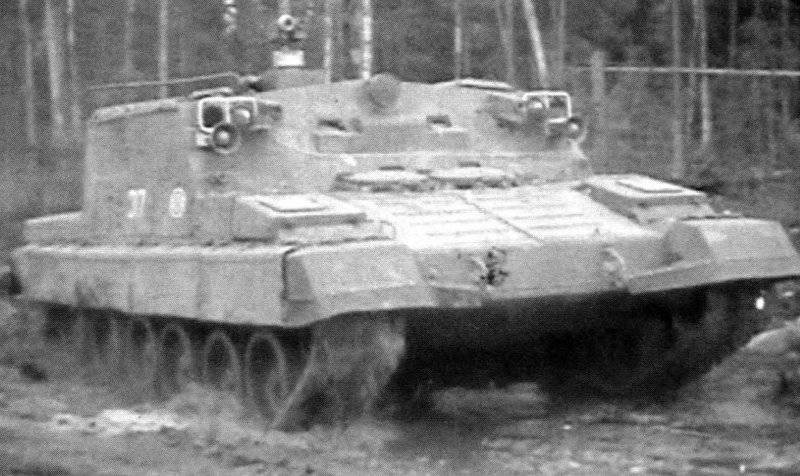
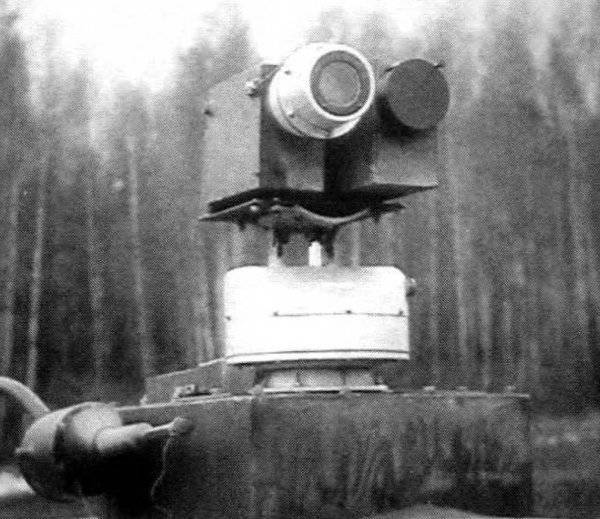


Information